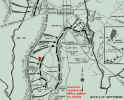
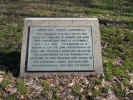
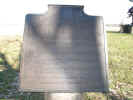
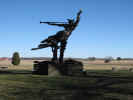
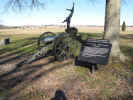
David Washington Pipes at Gettysburg
On the 3rd day at Gettysburg, Lee decided to force a large Infantry charge at the Union Lines. This famous moment has become well known as Pickett's Charge. The actual charge did not start until well into the afternoon on that day, but the charge was preceded by one of the largest and longest cannonades in military history.
At about 1pm, after the fighting on Culp's Hill had died down, the silence was broken by two successive cannon signal shots. Over 140 Confederate cannons then opened up on the center of the Union lines. Close to 80 northern guns answered as the two lines pounded each other for what has been estimated by people who were there, and some who were not, to be 1 to 2 hours.
Here is what David wrote in his memoirs about the event:
"At 7:30 p.m.[on July 2nd] General Longstreet sent for our Battery and after going over very rough roads, finally reach our destination and bivouac for the night, supposedly the firing had ceased and all operations were over for the day. During the night, Colonel Alexander, Chief of Artillery, had ordered our Battery to take a position on the Emmitsburg Road, on the left of the peach orchard, on ground taken yesterday and on a line with the other Batteries of the 1st Corps which were there in position. We went into position around 4 a.m. on the 3rd of July, on ground occupied by the enemy when Longstreet’s troops charged; The dead were still unburied, a nearby barn was full of wounded and their groans were pitiful and heart rendering during the still hours of the night. Later it was burned by shell fire from the enemy guns and most of these men perished and when the sun made its appearance in the east we could see Seminary Hill in our front, with several lines of breastworks thrown up during the night and a stone fence at the foot of the hill. We remained in this position under an arsenal of infantry and artillery fire until 1:30 p.m. when the battle was to open with a signal from the 1st company of our Battery, when these signal guns were fired, began the most furious cannonading the world had ever heard. One hundred and thirty seven Confederate guns were belching fire upon the enemy lines and replied to by 217 guns of the enemy. Our batteries continued their fire for nearly two hours, when the enemies’ guns slackened their fire, until they hardly returned shot for shot. I am told the report from these guns could be heard for eighty miles."
"Our loss in the Washington Artillery was three privates killed - 3 officers and 20 privates wounded, 39 horses killed. On my piece we lost, killed and disabled, nine of the 12 horses; our piece was disabled and our caisson blown up."
In 2010 my son Jason made a visit to the Gettysburg Battlefield and took some pictures of the monuments and the area where David Washington Pipes, Norcom's and Miller's Battery and Eshlemann's Brigade were located on July 3rd. Click on the thumbnails to see a larger picture.